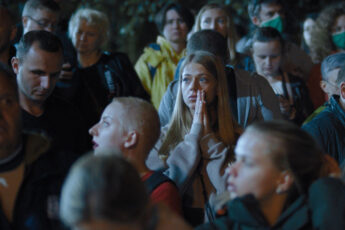
Salomé Jashi’s documentary Taming the Garden will likely be remembered for its cornerstone image: a giant tree sailing serenely across a turquoise sea. Piece by piece, the film divulges the mystery and the meaning of this intriguing and surreal snapshot of contemporary Georgia. As it turns out, the equally bizarre story behind it has the ring of a fable or parable: an obsessive ruler (in reality, billionaire ex-prime minister Bidzina Ivanishvili) sends out a team to scour his domain in search of the most beautiful trees in the land, then move heaven and earth to bring them back to add to the collection in his private garden.
Taking a dramaturgical approach structured around revelation rather than chronology, the film follows the fate of various trees in various regions at various stages in their journey. In any case, the individual trees are somewhat hard to keep track of since the process often involves hacking off large parts of them. At first, the whole endeavor is framed as idiosyncratic whimsy, bordering on benevolent or even charming. After all, the impoverished people living in the countryside are receiving sums beyond their wildest dreams and it’s not as if the forest were being totally eradicated. Gradually, however, it all gets cast in a more sinister light.
The first and most glaring issue is the sheer incomprehensible scale involved. These trees are truly massive and removing them is nothing less than herculean. Jashi plays with these notions of scale through the cinematography, with many wide shots composed to highlight the unfathomable diminutiveness of the people in relation to the plants. When removed from the ground, the cubes of earth encompassing the roots alone measure several human lengths in each direction. In one particularly standout shot, the camera stays still while a tree is dragged slowly out of frame, followed by a hoard of villagers who have gathered to bid it farewell. As the entourage passes into the distance like some kind of ancient pagan procession, the perspective becomes more and more bewildering. A similar emphasis is placed on the temporal aspect, with long takes showing the repetitive, endless work involved, while discussions between workers mention that removing each tree requires several months.
While this may have a certain otherworldly beauty to it, it also has very tangible effects on the earthly terrain where it is taking place. In order for one tree to be moved, many others have to be cut down, with havoc generally wreaked on the environment as a whole. Even more disturbingly, entire roads need to be built to allow such a giant object to pass through, harking back to the impressive but destructive infrastructural feats of the conquering Roman armies. This is where the film takes a more political turn. It becomes apparent that these people and these regions are institutionally neglected, and the locals could never dream of roads being built for their benefit, highlighting the absurd disparity between the hubristic needs of one man and entire swathes of the population. Moreover, this is often used as a tactic to convince the unpersuaded to either sell their trees or let their land be torn to shreds – if they want a road, this is the only way they’ll get it. At least this is what they’re told, though there are also those who are justifiably suspicious that none of the promises made will actually be kept, whether in terms of financial pay-outs or improvements to regional amenities.
The film provides almost no direct criticism or analysis, but it does tacitly provoke a range of questions concerning access to natural heritage and the relationships between a country and its physical landscapes. What does it say about a society when a single individual feels that he has the right to hoard the national ecology for his own private enjoyment? More generally, how is an individual permitted to get so rich to be able to even contemplate such a ridiculous plan, never mind actually put it into operation?
Then of course there are the relationships between the communities and their trees. In many cases, the saplings were first planted by an ancestor or, among the more elderly, the owners themselves. As one woman points out, “generations have played under these trees.” Another old lady would prefer to keep her chestnut tree for the sake of the annual harvest but feels pressured into selling it for the sake of her son. The effects of this literal uprooting in terms of both cultural and environmental implications can only be imagined with horror.
Needless to say, Salomé Jashi deserves credit for her choice of such a unique and sadly poignant subject, and also for foregrounding the visual aspect of the storytelling to reflect the poetic and allegorical quality of her core imagery, namely trees where trees shouldn’t be. However, the overall approach could perhaps have benefited from playing it less safe structurally – the visuals and concept are truly incredible, while by contrast the editing is overwhelmingly logical, preventing any real sense of either magic or anger. One way that the film falls flat is in the revelation of the mystery figure calling the shots. While Ivanishvili is named, there’s little explanation of who he actually is for anyone who may not already know, and while on the one hand this adds to the notion of him as a symbolic figure, the film thereby also loses crucial contextualization. Nevertheless, as a whole, Taming the Garden provides a spell-binding glimpse into the truly extraordinary logic adopted by the hyper-privileged, and we can only hope that the fairy-tale tyrant will get his comeuppance soon.




Leave a Comment